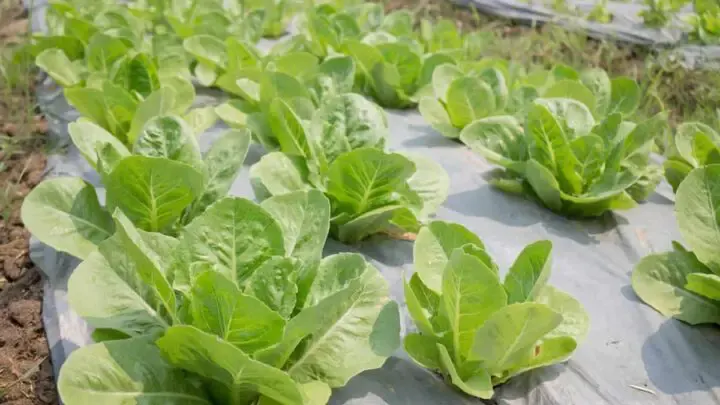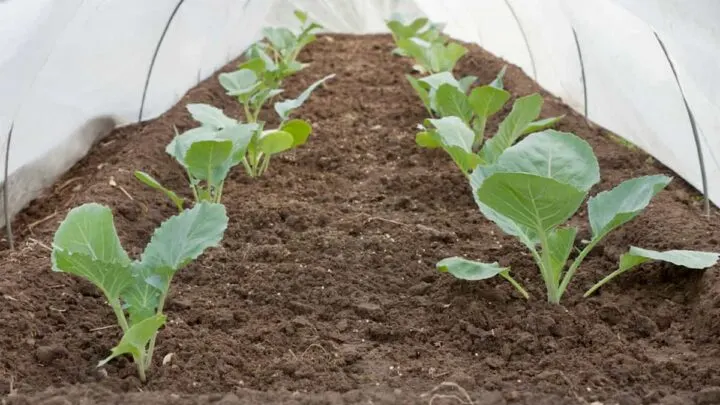Cabbage is a popular and versatile cool-season vegetable that can be planted in the garden in the spring and fall. Perhaps you’ve been thinking of options for a longer-growing season, even growing it year-round. You’ve heard of greenhouses, but you may not know much about something called a polytunnel. Can you grow cabbage in a polytunnel?
Cabbages can grow in a polytunnel, and doing so can protect them from frost and animals and extend the growing season, allowing you to enjoy this tasty vegetable year-round.
Now that you know that cabbage can grow in a polytunnel, you may have other questions. Let’s dive in to learn more about polytunnels, why it’s a good idea to grow cabbage in one, and much more!

What is a Polytunnel?
A polytunnel is a tunnel-shaped structure made from metal or plastic frame covered with polyethylene film. It comes in various sizes: large enough to walk and stand up in, or ones that cover the plants, with sizes in between.
Unlike a greenhouse, these can be a permanent structure in your garden and can be moved or taken down if needed. A polytunnel is much less expensive than a greenhouse and easier to install.
A polytunnel will shelter plants from frost, heat, sun, wind, rain, and animals. It provides a perfect environment for early germination in the spring. You can easily control and adjust humidity and airflow with the doors, vents, or other equipment available for polytunnels.
By protecting plants from frost, a polytunnel allows you to grow crops earlier or later in the season, perhaps even year-round, if your winters aren’t too cold. It can be insulated in the winter with bubble wrap or cover the plants inside. You can use a heater inside the polytunnel. You can also grow plants that wouldn’t normally grow in your climate.
You can water the plants with a watering can, hose, or an irrigation system. This can be overhead using a mist or drip system.
The polyethylene will generally last between 5 to 10 years, depending on the quality, before needing replacement. Different types allow more or less light into the tunnel.

Growing Cabbage Outside
Cabbage is a cool-season vegetable, usually planted in the spring or fall. There are several varieties available with different maturity times so that you can have a harvest in the summer and fall.
It’s important to add plenty of compost or manure into the soil before planting cabbage seeds or seedlings. Cabbage will need feeding every few weeks with a liquid fertilizer.
Cabbage heads can split from heavy rain. The roots absorb too much water, causing the leaves to expand quickly. The head will split due to the pressure from the excess water.
To prevent this, keep the soil consistently moist but not soggy. Mulch applied at the base of each plant will help maintain soil moisture.
How is a Polytunnel Better for Growing Cabbage?
With a polytunnel, it’s possible to enjoy eating cabbage all year round because it allows you to grow them successfully, even in winter if it’s not too cold. It’s also easier to control the watering for the plants and pests, which can be a problem for cabbages.
Advantages of Growing Cabbage in a Polytunnel
Advantages of growing cabbage in a polytunnel include:
- Polytunnels can warm up the soil so you can plant seeds earlier in the spring.
- They can help you to extend the growing season by planting three times per year instead of two.
- Polytunnels keep your plants safe from animals and some pests.
- They can prevent cabbage head splitting because the plants don’t get rained on. You control the watering.

Planting Cabbage Throughout the Year
There are three types of cabbage: spring cabbages, summer cabbages, and winter cabbages.
Sow spring cabbage seeds in July and August. Plant the seedlings in September and October to grow slowly over the winter. Harvest from late February through to early June.
Sow summer cabbage seeds from mid-February to mid-May. Plant the seedlings in May and June. Harvest from late June to November; the prime harvesting months are August and September.
Sow winter cabbage seeds in late April through May. Plant the seedlings in June and July. Harvest from October through to March.
Planting cabbage this way in a polytunnel avoids what is known as the ‘Hungry Gap.’ This refers to the period after stored produce runs out and before the spring crops are ready to harvest.
Spring and winter cabbages sown at these times of year will be able to begin growing before the cold weather arrives. They will remain primarily dormant over the coldest months but return to active growth when the weather warms up.
Final Thoughts
Cabbage is a popular vegetable in many recipes, from coleslaw to cabbage rolls, to sauerkraut. Since it can be eaten in cold and hot dishes, it’s the perfect vegetable to eat year-round.
As a gardener, you prefer to grow vegetables rather than buy them in a grocery store. By growing your cabbage plants in a polytunnel, you can have fresh cabbage virtually all year. Cabbage both stores and freezes well, so there is no reason to go without this healthy and tasty vegetable any time you desire.
Research polytunnels and see if one is right for you and your garden. They are inexpensive and come in many sizes so that you can start your cabbage plants in one soon.

Hi there, my name is Allie and welcome to my blog; GareningWithAllie!
Much of what you see written here is just our personal experiences with gardening. Along with the content I write here, there is also a unique collection of gardening topics covered by some of our close friends. I hope you find everything you read here to be helpful, informative, and something that can make your gardening journey the most lovely experience ever! With that said, Happy Gardening!
